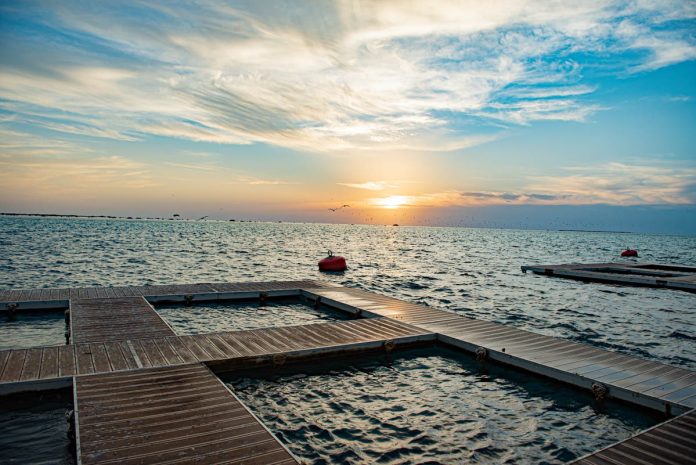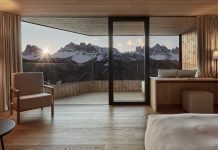Sign up to Simon Calder’s free travel email for weekly expert advice and money-saving discounts
Get Simon Calder’s Travel email
You’d easily miss Desert Rock if you didn’t know it was there. Nestled in a hidden valley among the mountaintops of the wadi vistas, the hotel is carved directly into stone. Like the historical sites of Petra and Al Ula, you’re invited to step into a natural landscape and learn from the wisdoms of the ancient Nabateans: how to live not on the land, but within it.
Think The Flintstones meets Disney for a new kind of tourism, steeped in heritage yet determined to break all records. Ecotourism is being re-invented on the banks of the Red Sea, on a scale never seen before – to show that going green can also bring in green dollars. At a cost of $25bn, on a site the size of Belgium, Red Sea Global aims to become the largest resort in the world powered by renewable energy.
For the past 70 years, the Middle East has overexploited its resources, blighting a long history of co-existence between man and the natural world. For centuries beforehand, nomads shaped the custom of the land; sites like Old Jeddah and the Al Qarah mountain have preserved the vestiges of a past steeped in sustainability.
As the tide continues to turn on oil, the Middle East has sought to offset its carbon emissions. The world’s first eco-city, Masdar, opened in the UAE in 2006. Egypt has Adrère Amellal, an entirely candlelit and electricity-free hotel where walls are made of salt-rock and the roof of palms. Something like Red Sea Global, however, is entirely in a league of its own.
The corals growing in the Red Sea’s nurseries are as dazzling as they are diverse
(Red Sea Global)
The first three hotels, opening this spring, will provide nearly 250 solar-powered rooms before the grand unveiling of nearly 3,000 more across 16 hotels by the end of next year. Twenty-three thousand construction workers are working towards a total of 50 hotels by 2030, on an area spanning 28,000 square kilometres.
The most impressive thing about Red Sea Global is that it doesn’t seem that big at all. Only from an aerial viewpoint does it become clear how vast the site is. We flew through the upper reaches and watched the golden sand unfurl across the dunes. Shrubs cascaded down ochre valleys as free-roaming camels looked up inquisitively. Then suddenly, we were above water: flamingos flew below us from islet to islet. This is a place where the desert meets the tropics, the arid tones of the dunes end where the sparkling turquoise of the lagoon begins.
Unlike other monumental projects like those in the UAE, Red Sea Global feels more like a small country than a resort. John Pagano, CEO, showed us around the immersive accommodation that is designed to blend into the landscape. Desert Rock, which opens in a year, is about as remote as a Namibian base camp, more than 25 kilometres from the nearest habitation. You become the steward of your own land, an intrepid explorer of the ancient ridge one minute and relaxing in a solar-powered bath the next.
Guests travel to their villas via boat or amphibious seaplane, powered by hydraulic energy. Twenty kilometres away, the Red Sea International Airport is due to be completed this year, allowing visitors to reach the resort in no time.
A marine biologist inspects coral in the underwater nurseries, teaming with ocean life
(Red Sea Global)
You get a real sense that this is somewhere people would actually live. Different sites across diverse terrains conjure different neighbourhoods, each with its own architectural character. We landed on Ummahat island where the villas rise slightly above the water, resembling giant corals that have been excavated. The roof made of locally sourced timber swirls all the way around each room, reminiscent of a spiral seashell.
Designed by Japanese architect Kengo Kuma, the C-shaped structure evokes the curves of the nearby desert dunes and the ebb and flow of the water below. As I walked through the apartment, I was struck by intricate wall carvings of marine flora, their abstract, undulating patterns a show of heritage within the brand-new.
A few miles down the coast, Sheybarah island offers something more radical still: suites in stainless-steel orbs. Each one weighs 130 tons and sits in a cantilever over the water, where it appears to float. Just as Kuma’s suites are warm and domestic, these are bold and futuristic.
All powered by photovoltaic energy funnelled from solar farms near the airport, there’s something here for everyone as Mohammad Bin Salman, whose belief in the importance of sustainability saw him launch the Saudi Green Initiative in 2021, attempts to balance his country’s use of oil.
For every man-made island with a resort, three natural islands remain untouched. Many of these are home to long-established turtle-nesting sites; sadly, I missed hatching season by a month. As has become custom in Saudi Arabia, people here like to go above and beyond. At Red Sea Global, conservation is merely the starting point for more ambitious regenerative projects.
The sustainably designed hotel accommodation is conceived to mirror the landscape.Sweeping curves recall the ebb and flow of the water
(Supplied)
I met with Dr Pamela Neubert, one of the marine biologists, who took me out by boat to see the coral nurseries her team is working on. We arrived just in time for sunset and hopped out of the boat onto wooden planks, from which ropes hang down to an underwater bed where corals bloom like virescent kaleidoscopes.
Dr Neubert grew up in Maine, where the wilderness of the Atlantic coast inspired her lifelong love of the ocean. The nurseries at Red Sea Global were set up to accommodate corals requiring relocation amid the construction of the resort. Under her supervision, however, they have gained a life of their own.
The team noticed there was potential for something that went beyond safeguarding coral reefs; indeed, that the unique conditions of the Red Sea allowed for experiments that could replenish reefs all over the planet.
The Red Sea is one of the world’s hottest: summer temperatures have historically reached 30 degrees Celsius. This means corals there have developed superior resistance to heat over time, and continue to flourish amid global warming. The Al Wajh lagoon, the fourth largest barrier reef system in the world – a stone’s throw from Red Sea Global – is intact. In Australia’s Great Barrier Reef, by contrast, climate change has caused no fewer than four mass bleaching incidents in the past decade.
Scientists at Red Sea Global are seeking out genetic strains responsible for the local coral’s superior resistance and aim to see if these may be transmuted around the world. Eager to find out more about this, I travelled to King Abdullah University of Science and Technology, one of Red Sea Global’s partners, where Dr Shannon Klein outlined two possible solutions.
A team of construction workers on one of Red Sea Global’s islands
(Supplied)
The first is to use more resistant corals from deeper reefs to repopulate those that have been bleached in shallower waters. The second, more radical solution is hybridisation: crossing the genes of two coral species to form a third, hardier specimen.
This kind of genetic engineering is certain to trigger alarm bells from environmental purists; but in this instance human interference may simply be corrective, compensating for a lifetime of negligence that now risks the survival of marine ecosystems in many parts of the planet.
As with most major projects, it’s best to start small. At Red Sea Global, the coral nurseries allow scientists to recreate and analyse the coral ecosystem in miniature. After studying what conditions each species needs to thrive, in-lab corals are spawned and nurtured from gamete to juvenile stages before being targeted for placement in the nurseries. These have a survival rate of over 95 per cent. Hybrids could soon follow.
This is a place where bright minds are drawn to bold innovations, where holidaymakers rub shoulders with scientists and engineers. It’s a place of work as well as repose, where a village is being built to accommodate 40,000 people keen to get out Riyadh and embrace a life by the sea.
It’s almost like a commune – not least because Red Sea Global has been granted privileges to create its own special economic zone. This means residents won’t be bound by the same conservative rules that apply to the rest of the country. You can, as you would elsewhere, sip piña coladas and have a boogie with your partner on the beach under a moonlit sky.
Unlock the world’s wonders with unforgettable journeys tailored just for you! Whether you crave sun-kissed beaches, thrilling adventures, or rich cultural escapes, your dream destination awaits. Enjoy seamless travel with expert tips, exclusive deals, and handpicked experiences that Turn Every Trip into a lifetime memory.










